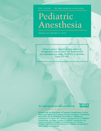Pediatric cardiopulmonary arrest in the postanesthesia care unit: analysis of data from the American Heart Association Get With The Guidelines®-Resuscitation registry
Summary
Background
Nearly 20% of anesthesia-related pediatric cardiopulmonary arrests (CPAs) occur during emergence or recovery. The aims of this study were to describe (i) the nature of pediatric postanesthesia care unit (PACU) CPA and subsequent outcomes and (ii) factors associated with mortality.
Methods
Cardiopulmonary Arrests occurring in PACU in children (<18 years) were identified from the American Heart Association Get With The Guidelines®-Resuscitation, multicenter CPA registry. Demographics, underlying conditions, cause(s) of CPA, monitoring, interventions and outcomes were extracted. Descriptive statistics were used to characterize data, and odds ratios (OR) with confidence intervals (CI) were calculated as appropriate to compare survivors and nonsurvivors.
Results
Twenty seven CPA events were included: 67% in children <5 years and 30% in infants (<1 year). Most children (78%) had underlying comorbidities, including 15% with congenital heart disease. Respiratory issues were the most frequent causes of CPA (44%), but cardiac/hemodynamic causes were associated with nonsurvival (P = 0.01). Nonsurvival was also associated with older age (P = 0.02), weekend occurrence (P < 0.01), nonpediatric setting (P = 0.02) and occurrence at night (P = 0.04).
Conclusions
This study identified similar risk factors and underlying causes as described in previous reports of pediatric perioperative CPA, with higher mortality following a cardiac/hemodynamic cause.




